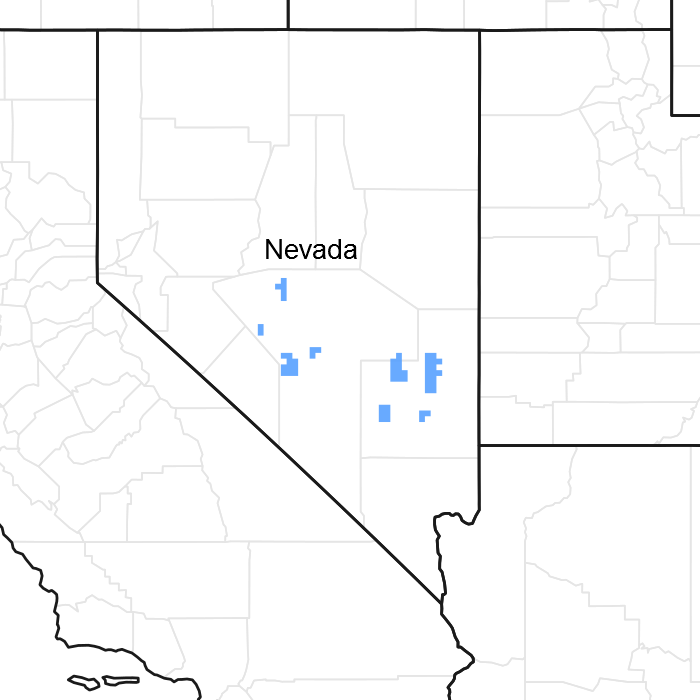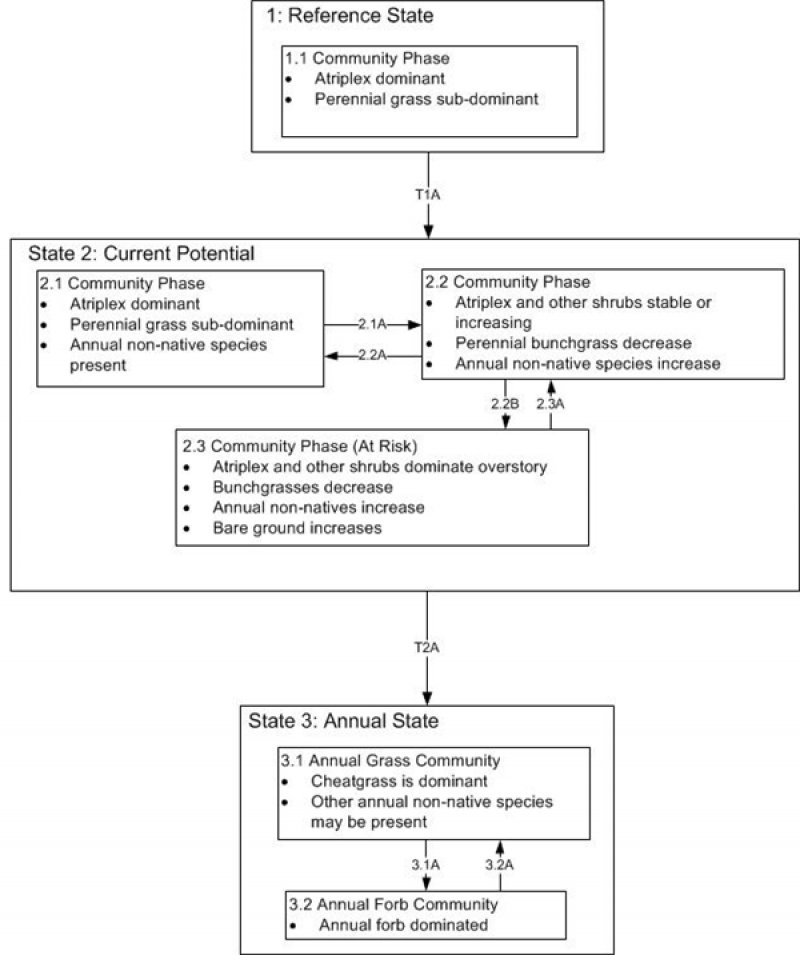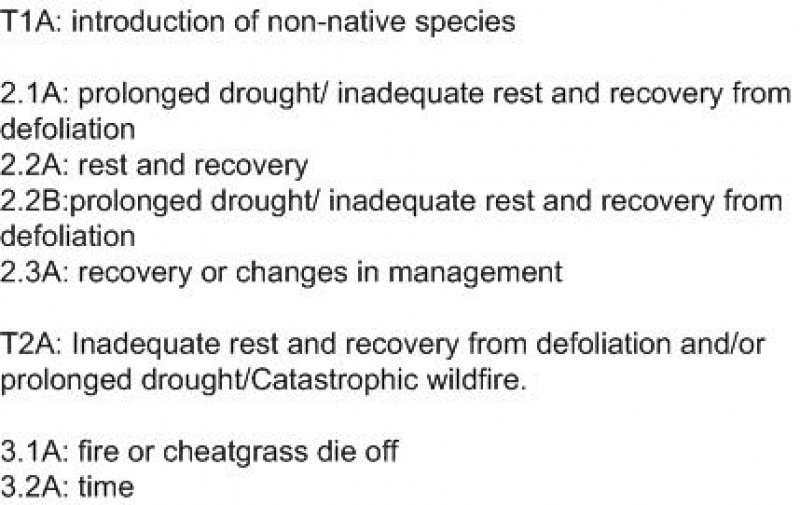
Natural Resources
Conservation Service
Ecological site R029XY059NV
SHALLOW SILTY 5-8 P.Z.
Accessed: 04/30/2025
General information
Provisional. A provisional ecological site description has undergone quality control and quality assurance review. It contains a working state and transition model and enough information to identify the ecological site.

Figure 1. Mapped extent
Areas shown in blue indicate the maximum mapped extent of this ecological site. Other ecological sites likely occur within the highlighted areas. It is also possible for this ecological site to occur outside of highlighted areas if detailed soil survey has not been completed or recently updated.
Associated sites
| R029XY020NV |
SILTY 5-8 P.Z. |
|---|---|
| R029XY024NV |
SODIC TERRACE 5-8 P.Z. |
| R029XY076NV |
SODIC FLAT |
Similar sites
| R029XY017NV |
LOAMY 5-8 P.Z. ATCO-ARSP5 codominant; greater shrub diversity; not on lake planes |
|---|---|
| R029XY024NV |
SODIC TERRACE 5-8 P.Z. SAVE4 codominant shrub |
Table 1. Dominant plant species
| Tree |
Not specified |
|---|---|
| Shrub |
(1) Atriplex confertifolia |
| Herbaceous |
Not specified |
Physiographic features
This site occurs on lake plains and lake plain terraces of basin floors. Slopes gradients of 0 to 4 percent are most typical. Elevations are 3500 to about 6500 feet.
Table 2. Representative physiographic features
| Landforms |
(1)
Lake plain
|
|---|---|
| Flooding duration | Brief (2 to 7 days) |
| Flooding frequency | Occasional |
| Elevation | 1,067 – 1,981 m |
| Slope | 0 – 4% |
| Aspect | Aspect is not a significant factor |
Climatic features
The climate associated with this site is arid, characterized by cool, moist winters and hot, dry summers. Average annual precipitation is 4 to about (6)8 inches. Mean annual air temperature is 50 to 57 degrees F. The average growing season is about 120 to 160 days.
Table 3. Representative climatic features
| Frost-free period (average) | 160 days |
|---|---|
| Freeze-free period (average) | 0 days |
| Precipitation total (average) | 203 mm |
Figure 2. Monthly average minimum and maximum temperature
Influencing water features
This site is occasionally flooded from runoff from adjacent, higher landscapes.
Soil features
The soils associated with this site have formed in alluvium over lacustrine deposits derived from mixed rock sources. The soils are very deep and are well drained. Permeability is slow and available water holding capacity is low to moderate. These soils have the potential for formation of gullies, especially in areas near shallow drainageways. The soils are usually moist in winter and spring and dry in summer and fall, except for 10 to 20 days between July and October due to convection storms. The soil moisture regime is aridic bordering on xeric and the soil temperature regime is mesic. Soil series associated with this site include: Ambush and Slaw. Ambush has a calcic horizon from 5 to 31 inches.
Table 4. Representative soil features
| Surface texture |
(1) Fine sandy loam (2) Silt loam |
|---|---|
| Family particle size |
(1) Loamy |
| Drainage class | Well drained |
| Permeability class | Slow |
| Soil depth | 183 – 213 cm |
| Surface fragment cover <=3" | 0% |
| Surface fragment cover >3" | 0% |
| Available water capacity (0-101.6cm) |
11.94 – 18.54 cm |
| Calcium carbonate equivalent (0-101.6cm) |
0 – 35% |
| Electrical conductivity (0-101.6cm) |
0 – 32 mmhos/cm |
| Sodium adsorption ratio (0-101.6cm) |
0 – 30 |
| Soil reaction (1:1 water) (0-101.6cm) |
7.9 – 9.6 |
| Subsurface fragment volume <=3" (Depth not specified) |
0 – 40% |
| Subsurface fragment volume >3" (Depth not specified) |
0% |
Ecological dynamics
Where management results in abusive grazing use by livestock and/or feral horses, Indian ricegrass, bottlebrush squirreltail, and palatable shrub species will decrease allowing shadscale to completely dominate the site except for invader species. Species likely to invade this site are cheatgrass, halogeton, Russian thistle and mustards.
Fire Ecology:
The mean fire return interval for shadscale communities range from 35 to 100 years. Shadscale communities are usually unaffected by fire because of low fuel loads, although a year of exceptionally heavy winter rains can generate fuels by producing a heavy stand of annual forbs and grasses. Increased presence of non-native annual grasses, such as cheatgrass, can alter fire regimes in shadscale communities by increasing fire frequency under wet to near-normal summer moisture conditions. When fire does occur, the effect on the ecosystem may be extreme. Indian ricegrass can be killed by fire, depending on severity and season of burn. Indian ricegrass reestablishes on burned sites through seed dispersed from adjacent unburned areas. Bottlebrush squirreltail's small size, coarse stems, and sparse leafy material aid in its tolerance of fire. Postfire regeneration occurs from surviving root crowns and from on- and off-site seed sources. Frequency of disturbance greatly influences postfire response of bottlebrush squirreltail. Undisturbed plants within a 6 to 9 year age class generally contain large amounts of dead material, increasing bottlebrush squirreltail's susceptibility to fire.
State and transition model

Figure 3. DRAFT STM

Figure 4. DRAFT STM LEGEND
More interactive model formats are also available.
View Interactive Models
More interactive model formats are also available.
View Interactive Models
Click on state and transition labels to scroll to the respective text
Ecosystem states
State 1 submodel, plant communities
State 1
Reference State
Community 1.1
Reference Plant Community
The reference plant community is dominated by shadscale. Potential vegetative composition is about 10% grasses, 5% forbs and 85% shrubs. Approximate ground cover (basal and crown) is 15 to 25 percent.
Figure 5. Annual production by plant type (representative values) or group (midpoint values)
Table 5. Annual production by plant type
| Plant type | Low (kg/hectare) |
Representative value (kg/hectare) |
High (kg/hectare) |
|---|---|---|---|
| Shrub/Vine | 191 | 358 | 476 |
| Grass/Grasslike | 22 | 41 | 56 |
| Forb | 11 | 21 | 28 |
| Total | 224 | 420 | 560 |
State 2
Current Potenital
State 3
Annual State
Additional community tables
Table 6. Community 1.1 plant community composition
| Group | Common name | Symbol | Scientific name | Annual production (kg/hectare) | Foliar cover (%) | |
|---|---|---|---|---|---|---|
|
Grass/Grasslike
|
||||||
| 1 | Primary Perennial Grasses | 18–55 | ||||
| Indian ricegrass | ACHY | Achnatherum hymenoides | 9–34 | – | ||
| squirreltail | ELEL5 | Elymus elymoides | 9–21 | – | ||
| 2 | Secondary Perennial Grasses | 1–21 | ||||
| threeawn | ARIST | Aristida | 2–9 | – | ||
| King's eyelashgrass | BLKI | Blepharidachne kingii | 2–9 | – | ||
|
Forb
|
||||||
| 3 | Perennial | 9–34 | ||||
| Indian ricegrass | ACHY | Achnatherum hymenoides | 9–34 | – | ||
| squirreltail | ELEL5 | Elymus elymoides | 9–21 | – | ||
| globemallow | SPHAE | Sphaeralcea | 2–9 | – | ||
| 4 | Annual | 1–12 | ||||
|
Shrub/Vine
|
||||||
| 5 | Primary Shrubs | 295–336 | ||||
| shadscale saltbush | ATCO | Atriplex confertifolia | 295–336 | – | ||
| 6 | Secondary Shrubs | 26–76 | ||||
| fourwing saltbush | ATCA2 | Atriplex canescens | 4–12 | – | ||
| green molly | BAAM4 | Bassia americana | 4–12 | – | ||
| yellow rabbitbrush | CHVIP4 | Chrysothamnus viscidiflorus ssp. puberulus | 4–12 | – | ||
| Nevada jointfir | EPNE | Ephedra nevadensis | 4–12 | – | ||
| spiny hopsage | GRSP | Grayia spinosa | 4–12 | – | ||
| winterfat | KRLA2 | Krascheninnikovia lanata | 4–12 | – | ||
| bud sagebrush | PIDE4 | Picrothamnus desertorum | 4–12 | – | ||
| greasewood | SAVE4 | Sarcobatus vermiculatus | 4–12 | – | ||
Interpretations
Animal community
Livestock Interpretations:
This site has limited value for livestock grazing due to low forage production. Grazing management should be keyed to perennial grass production. Indian ricegrass has good forage value for domestic sheep, cattle and horses. It supplies a source of green feed before most other native grasses have produced much new growth. Bottlebrush squirreltail is very palatable winter forage for domestic sheep of Intermountain ranges. Domestic sheep relish the green foliage. Overall, bottlebrush squirreltail is considered moderately palatable to livestock. Shadscale is a valuable browse species, providing a source of palatable, nutritious forage for a wide variety of livestock. Shadscale provides good browse for domestic sheep. Shadscale leaves and seeds are an important component of domestic sheep and cattle winter diets.
Stocking rates vary over time depending upon season of use, climate variations, site, and previous and current management goals. A safe starting stocking rate is an estimated stocking rate that is fine tuned by the client by adaptive management through the year and from year to year.
Wildlife Interpretations:
Shadscale is a valuable browse species, providing a source of palatable, nutritious forage for a wide variety of wildlife particularly during spring and summer before the hardening of spiny twigs. It supplies browse, seed, and cover for birds, small mammals, rabbits, deer, and pronghorn antelope. Indian ricegrass is an important forage for several wildlife species. Bottlebrush squirreltail is a dietary component of several wildlife species.
Hydrological functions
Runoff is low to high. Permeability is slow.
Recreational uses
Aesthetic value is derived from the floral and faunal composition . This site offers rewarding opportunities to photographers and for nature study. This site is used for camping and hiking and has potential for upland and big game hunting.
Other products
Seeds of shadscale were used by Native Americans of Arizona, Utah and Nevada for bread and mush. Indian ricegrass was traditionally eaten by some Native American peoples. The Paiutes used seed as a reserve food source.
Other information
Indian ricegrass is well-suited for surface erosion control and desert revegetation although it is not highly effective in controlling sand movement. Bottlebrush squirreltail is tolerant of disturbance and is a suitable species for revegetation.
Supporting information
Type locality
| Location 1: Lincoln County, NV | |
|---|---|
| Township/Range/Section | T6S R63E S35 |
| Latitude | 37° 23′ 1″ |
| Longitude | 114° 53′ 38″ |
| General legal description | Section 35, T6S. R63E. MDBM. Delamar Flat, Delamar Valley area, Lincoln County, Nevada. This site also occurs in Esmerelda, Mineral and Nye counties, Nevada. |
Other references
Fire Effects Information System (Online; http://www.fs.fed.us/database/feis/plants/).
USDA-NRCS Plants Database (Online; http://www.plants.usda.gov)
Contributors
BOD/GED
Rangeland health reference sheet
Interpreting Indicators of Rangeland Health is a qualitative assessment protocol used to determine ecosystem condition based on benchmark characteristics described in the Reference Sheet. A suite of 17 (or more) indicators are typically considered in an assessment. The ecological site(s) representative of an assessment location must be known prior to applying the protocol and must be verified based on soils and climate. Current plant community cannot be used to identify the ecological site.
| Author(s)/participant(s) | P NOVAK-ECHENIQUE |
|---|---|
| Contact for lead author | State Rangeland Management Specialist |
| Date | 05/20/2013 |
| Approved by | |
| Approval date | |
| Composition (Indicators 10 and 12) based on | Annual Production |
Indicators
-
Number and extent of rills:
Rills are none to rare. -
Presence of water flow patterns:
Water flow patterns are often numerous after summer convection storms where run-in occurs on lake plains. -
Number and height of erosional pedestals or terracettes:
Pedestals are rare with occurrence typically limited to areas within water flow patterns. -
Bare ground from Ecological Site Description or other studies (rock, litter, lichen, moss, plant canopy are not bare ground):
Bare Ground 65 to 75% -
Number of gullies and erosion associated with gullies:
These soils have potential for gully formation where concentration of overland flows occurs. -
Extent of wind scoured, blowouts and/or depositional areas:
None -
Amount of litter movement (describe size and distance expected to travel):
Fine litter (foliage from grasses and annual & perennial forbs) expected to move distance of slope length during intense summer convection storms or rapid snowmelt events. Persistent litter (large woody material) will remain in place except during large rainfall events. -
Soil surface (top few mm) resistance to erosion (stability values are averages - most sites will show a range of values):
Soil stability values should be 1 to 4 on most soil textures found on this site. Soils having thin surface sand sheet will have low stability values. (To be field tested.) -
Soil surface structure and SOM content (include type of structure and A-horizon color and thickness):
Structure of soil surface typically is medium platy. Soil surface colors are pale browns and soils are typified by an ochric epipedon. Organic matter of the surface 2 to 3 inches is less than 1 percent. Surface soils are typically very fine sandy loams to silt loams. The surface layer of these soils will normally develop a vesicular crust, inhibiting water infiltration and seedling emergence. -
Effect of community phase composition (relative proportion of different functional groups) and spatial distribution on infiltration and runoff:
Sparse shrub canopy and associated litter provide some protection from raindrop impact. -
Presence and thickness of compaction layer (usually none; describe soil profile features which may be mistaken for compaction on this site):
Compacted layers are none. Platy or massive sub-surface horizons are not to be interpreted as compacted layers. -
Functional/Structural Groups (list in order of descending dominance by above-ground annual-production or live foliar cover using symbols: >>, >, = to indicate much greater than, greater than, and equal to):
Dominant:
Low-statured shrub (shadscale)Sub-dominant:
associated shrubs > deep-rooted, cool season, perennial bunchgrass (Indian ricegrass) > shallow-rooted, cool season, perennial bunchgrasses > deep-rooted, cool season, perennial forbs > annual forbsOther:
Warm season perennial grassesAdditional:
-
Amount of plant mortality and decadence (include which functional groups are expected to show mortality or decadence):
Dead branches within individual shrubs common and standing dead shrub canopy material may be as much as 35% of total woody canopy; mature bunchgrasses commonly (±25%) have dead centers. -
Average percent litter cover (%) and depth ( in):
Between plant interspaces 10-20% and depth < ¼ in -
Expected annual annual-production (this is TOTAL above-ground annual-production, not just forage annual-production):
For normal or average growing season (February thru May) ± 375 lbs/ac; Favorable years ± 500 lbs/ac and unfavorable years ± 200 lbs/ac. -
Potential invasive (including noxious) species (native and non-native). List species which BOTH characterize degraded states and have the potential to become a dominant or co-dominant species on the ecological site if their future establishment and growth is not actively controlled by management interventions. Species that become dominant for only one to several years (e.g., short-term response to drought or wildfire) are not invasive plants. Note that unlike other indicators, we are describing what is NOT expected in the reference state for the ecological site:
Potential invaders include halogeton, Russian thistle, annual mustards, and cheatgrass. -
Perennial plant reproductive capability:
All functional groups should reproduce in average and above average growing season years. Little growth or reproduction occurs during extreme or extended drought periods.
Print Options
Sections
Font
Other
The Ecosystem Dynamics Interpretive Tool is an information system framework developed by the USDA-ARS Jornada Experimental Range, USDA Natural Resources Conservation Service, and New Mexico State University.
Click on box and path labels to scroll to the respective text.